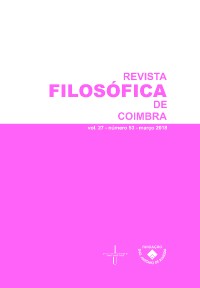Please use this identifier to cite or link to this item:
https://hdl.handle.net/10316.2/46458| Title: | Idades de ouro, idades de ferro: presente e passado míticos em Hesíodo | Other Titles: | Golden ages, iron ages: mythical present and past in Hesiod | Authors: | Lima, Paulo Alexandre | Keywords: | Cyclical temporality;myth of ages;mythical categories;Temporalité cyclique;mythe des âges;catégories mythiques;Temporalidade cíclica;mito das idades;categorias míticas | Issue Date: | 2018 | Publisher: | Imprensa da Universidade de Coimbra | Abstract: | O mito das idades deve ser entendido como algo que muda o estatuto de Os trabalhos e os dias, pois explica o tempo presente através de categorias míticas. O sentido geral do mito é o de uma degeneração das idades. Ao longo dessa degeneração, há dois momentos de regeneração, nos quais ocorrem dois tipos de “regresso” à idade de ouro e duas manifestações de temporalidade cíclica. A idade de ouro e a idade de ferro formam, em conjunto, os dois principais pilares da composição do mito. É na alternativa, com a qual estão confrontados os habitantes da idade de ferro, entre bem/justiça e mal/injustiça que se jogam o sentido último do mito e a possibilidade da segunda manifestação de uma temporalidade cíclica. Le mythe des âges doit être compris comme quelque chose qui change le statut du poème Les travaux et les jours, car il explique le temps présent à travers de catégories mythiques. La signification générale du mythe est celle d’une dégénérescence des âges. Tout au long de cette dégénérescence, il y a deux moments de régénération, où il y a deux sortes de “retours” à l’âge d’or et deux manifestations de la temporalité cyclique. L’âge d’or et l’âge de fer forment ensemble les deux principaux piliers de la composition du mythe. Dans l’alternative, à laquelle le peuple de fer est confronté, entre le bien/la justice et le mal/l’injustice, le sens ultime du mythe et la possibilité d’une seconde manifestation de la temporalité cyclique sont en jeu. The myth of ages should be understood as changing the status of the Works and Days, for it explains the present times by means of mythical categories. The general sense of the myth is a degeneration of ages. Along the way, there are two moments of regeneration, where two kinds of “return” to the golden age and two manifestations of cyclical temporality occur. Together, the iron and the golden age form the two major pillars in the composition of the myth. In the alternative, which the iron people are confronted with, between good and justice/evil and injustice, the ultimate meaning of the myth and the possibility of the second manifestation of cyclical temporality are at stake. |
URI: | https://hdl.handle.net/10316.2/46458 | ISSN: | 0872-0851 | DOI: | 10.14195/0872-0851_53_4 | Rights: | open access |
| Appears in Collections: | Revista Filosófica de Coimbra |
Files in This Item:
| File | Description | Size | Format | |
|---|---|---|---|---|
| idade_de_ouro.pdf | 723.57 kB | Adobe PDF |  |
Items in DSpace are protected by copyright, with all rights reserved, unless otherwise indicated.
